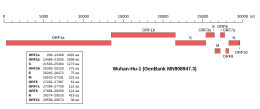ORF7a
Gene found in coronaviruses of the Betacoronavirus genus From Wikipedia, the free encyclopedia
ORF7a (also known by several other names, including SARS coronavirus X4, SARS-X4, ORF7a, or U122)[1] is a gene found in coronaviruses of the Betacoronavirus genus. It expresses the Betacoronavirus NS7A protein, a type I transmembrane protein with an immunoglobulin-like protein domain. It was first discovered in SARS-CoV, the virus that causes severe acute respiratory syndrome (SARS).[2] The homolog in SARS-CoV-2, the virus that causes COVID-19, has about 85% sequence identity to the SARS-CoV protein.[3]
Function
A number of possible functions for the ORF7a protein have been described. The primary function is thought to be immunomodulation and interferon antagonism. The protein is not essential for viral replication.[1]
Viral protein interactions
Studies in SARS-CoV suggest that the protein forms protein-protein interactions with spike protein and ORF3a, and is present in mature virions, making it a minor viral structural protein.[1][4] It is unclear if this occurs in SARS-CoV-2.[5] It may have a role in viral assembly.[1]
Host effects
A number of interactions with host proteins and effects on host cell processes have been described. The SARS-CoV ORF7a protein has been reported to have binding activity to integrin I domains.[6]
It has also been reported to induce apoptosis via a caspase dependent pathway.[1][7] Also, it contains a motif which has been demonstrated to mediate COPII dependent transport out of the endoplasmic reticulum, and the protein is targeted to the Golgi apparatus.[8]
In SARS-CoV-2, ORF7a protein has been described as an effective interferon antagonist.[3] The SARS-CoV-2 protein may have immunomodulatory effects through interaction with monocytes.[5]
Structure
The ORF7a protein is a transmembrane protein with 121 amino acid residues in SARS-CoV-2[5] and 122 in SARS-CoV.[2] It is a type I transmembrane protein with an N-terminal signal peptide, an ectodomain that has an immunoglobulin fold, and a C-terminal endoplasmic reticulum retention signal sequence.[5][6][1] The structure contains seven beta strands which form two beta sheets, arranged in a beta sandwich.[2] Most of the sequence differences between SARS-CoV and SARS-CoV-2 occur in the Ig-like ectodomain and may produce differences in protein-protein interactions.[5]
Post-translational modifications
The SARS-CoV-2 ORF7a protein has been reported to be post-translationally modified by ubiquitination. Polyubiquitin chains attached to lysine 119 may be related to the protein's reported interferon antagonism.[3][9]
Expression and localization
 Genomic organisation of isolate Wuhan-Hu-1, the earliest sequenced sample of SARS-CoV-2, indicating the location of ORF7a | |
| NCBI genome ID | 86693 |
|---|---|
| Genome size | 29,903 bases |
| Year of completion | 2020 |
| Genome browser (UCSC) | |
Along with the genes for other viral accessory proteins, the ORF7a gene is located near those encoding the viral structural proteins, at the 5' end of the coronavirus RNA genome.[3] ORF7a is an overlapping gene that overlaps ORF7b.[10] In SARS-CoV, subcellular localization to the endoplasmic reticulum, Golgi apparatus, and ERGIC has been reported,[1] with similar Golgi localization described for SARS-CoV-2.[11]
Evolution
Summarize
Perspective

It is thought that ORF8 in SARS-CoV-2, which encodes a protein with a similar Ig-like fold, may be a paralog of ORF7a that originated through gene duplication,[13][14] though some bioinformatics analyses suggest the similarity may be too low to support duplication, which is relatively uncommon in viruses.[15] Immunoglobulin domains are uncommon in coronaviruses; other than the subset of betacoronaviruses with ORF8 and ORF7a, only a small number of bat alphacoronaviruses have been identified as containing likely Ig domains, while they are absent from gammacoronaviruses and deltacoronaviruses.[16][14] The beta and alpha Ig domains may be independent acquisitions, where ORF8 and ORF7a may have been acquired from host proteins.[16]
Many SARS-CoV-2 genomes have been sequenced throughout the COVID-19 pandemic and a number of variations have been reported, including deletion mutations,[17] nonsense mutations (introducing a premature stop codon and truncating the protein),[18] and at least one gene fusion.[19] Recent analyses indicate that the repeated knockout of ORF8 in SARS-CoV-2 through deletion mutations is driven by positive selection, suggesting an adaptive advantage for the virus during human infection. The study showed ORF8 deletions were associated with less severe clinical disease. [20]
References
Wikiwand - on
Seamless Wikipedia browsing. On steroids.

